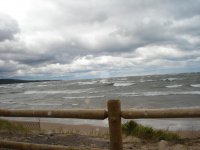Sorry you got that from my post, but I am by no means calling you clueless kwikgren.
What I am saying is that the reduction of fetch impacts ALL snow bands and is not selective in nature. Thus all areas downwind that are impacted by the LES snow bands see an equal reduction in snow, rather than some areas seeing more and some being less. LES forms by cold, unstable air traveling over relatively warmer waters. It picks up moisture and heat from the lake and causes the atmosphere to become increasingly unstable, to the point where clouds and precip form. Reducing the amount of time (fetch) that the air remains over the water reduces this process. However, once the air is over land, the process stops, so no enhancement can be done to areas inland, based on fetch.
It is certainly possible that strong winds can blow the banding further inland than is typical in LES regimes with less strong winds and that was likely the case in the event Friday night-Sat. However, the reduction in fetch did not lead to a reduction in snow across one area with an increase in others.
As far as the temps you experienced, I guess I would be interested to know how you were in two different places at one time? To travel from Mohawk to Herman takes approximately 70-80 minutes (if you do the speed limit) and temps at my house did warm from near freezing around daybreak (when we were picking up some accumulating snow) to the mid 30's just an hour or two later, once the solar energy started to kick in. So it is likely that while you measured temps of around 32 in Herman by the time you got there, that was after some warming had taken place and temps were likely in the upper 20's late Fri-early Sat, prior to sunrise, when the snow accumulated in places like Herman.
I agree, Karl did a great job of forecasting the snowfall outlay. His choice of using data from the WRF was a good call. As I have said in the past on this board, Karl is a friend of mine and I think a lot of folks living within his broadcasting reach do not realize how lucky they are to have someone of his talents in such a small market. Not sure what prompted the NWS to issue the advisories for snow as I did not read any of their discussions in that time frame. I certainly do not mean to pick on them as I feel they do a great job in a very difficult area to forecast for too, but there was not a single model that I saw that was calling for the type of snow that would bring about advisories. Most were calling for a sloppy 1/2 to 1" of snow to fall in mainly inland locations not effected by the marine layer, with the tiny bulls-eye of 2-4" in the higher terrain of eastern Baraga County.
-John

